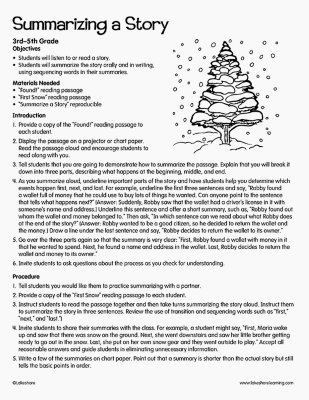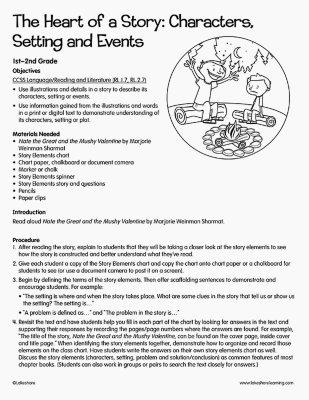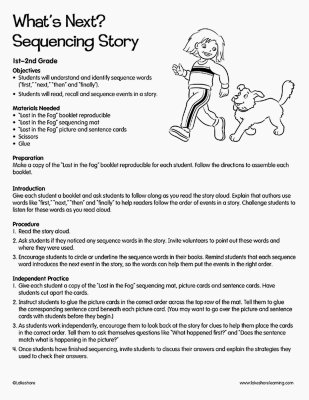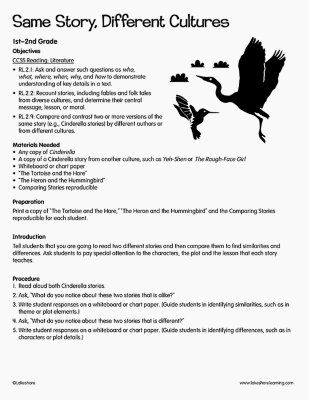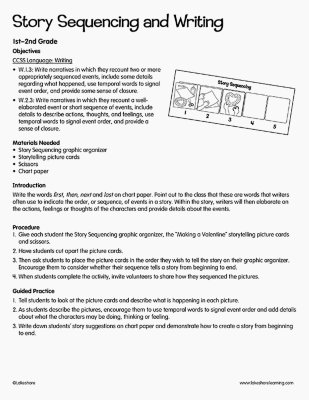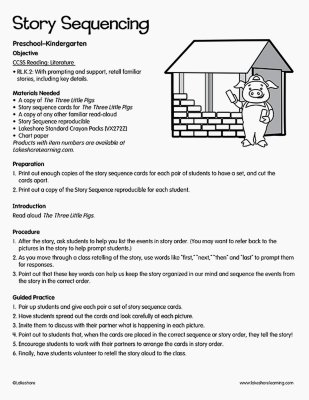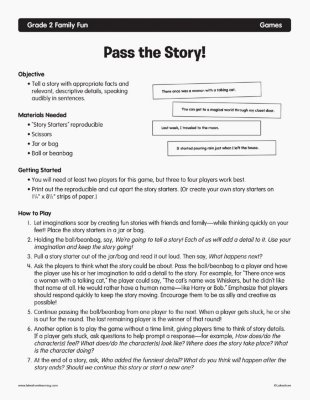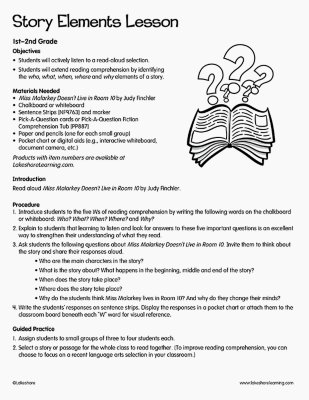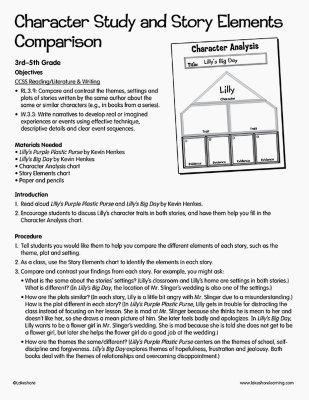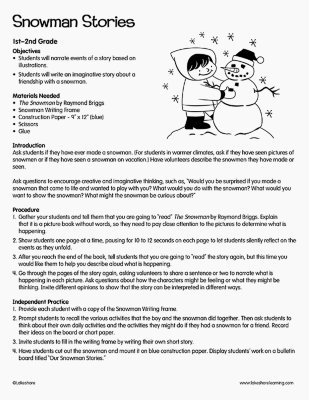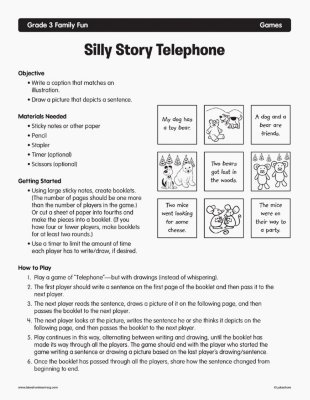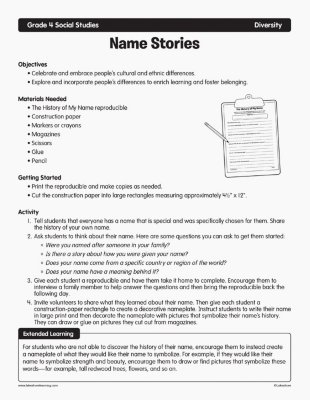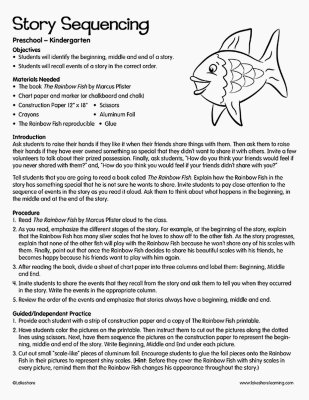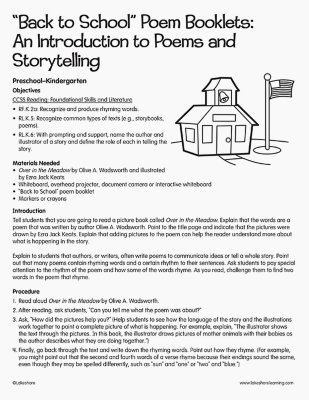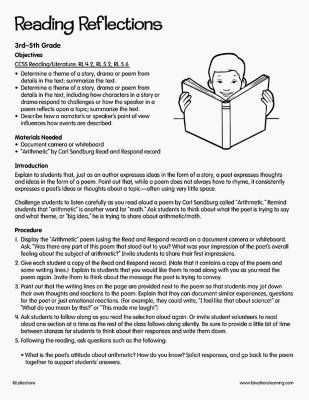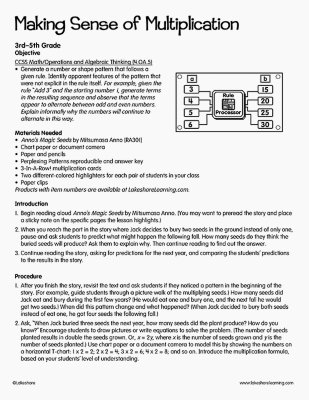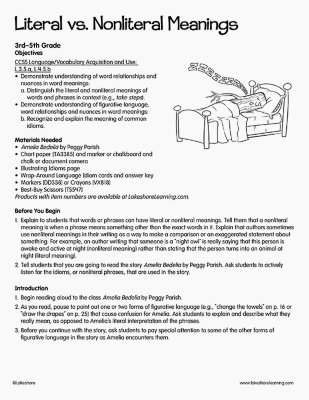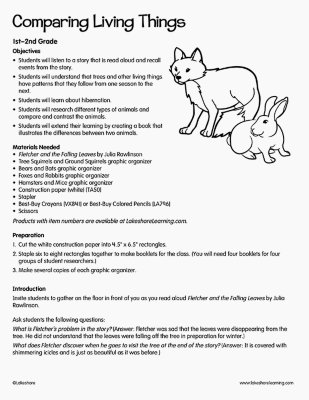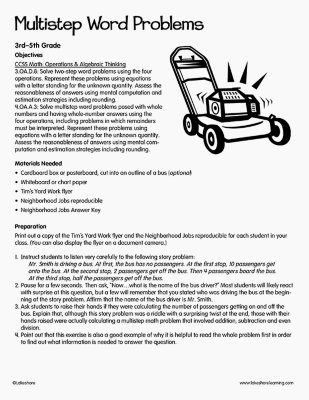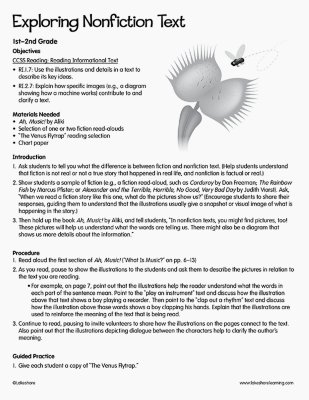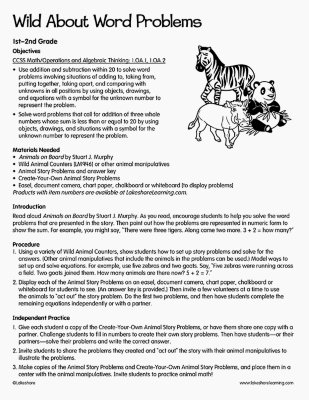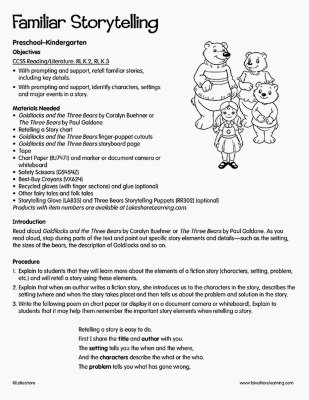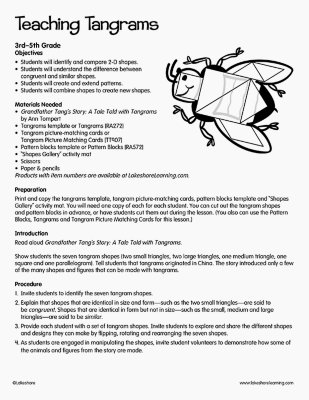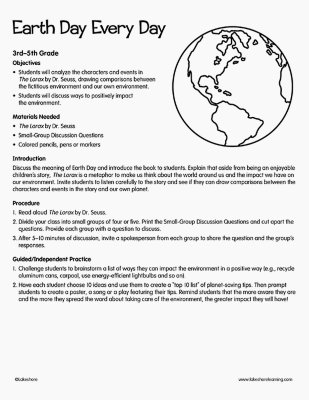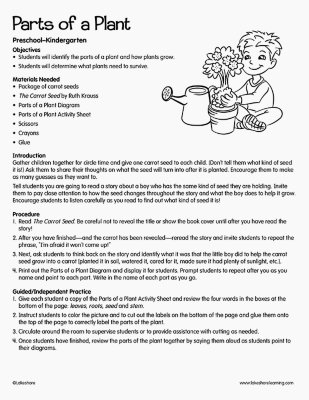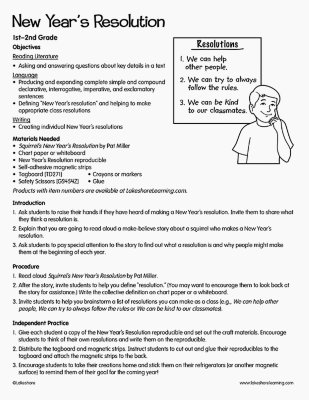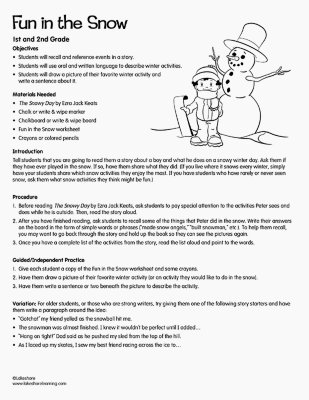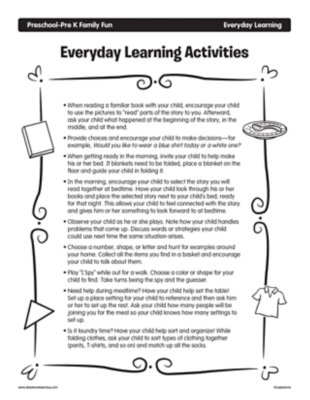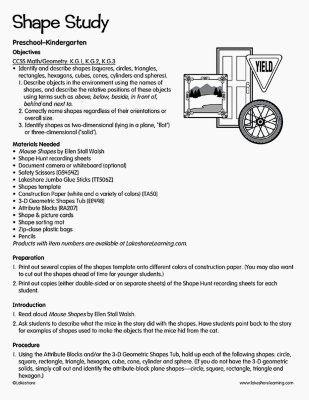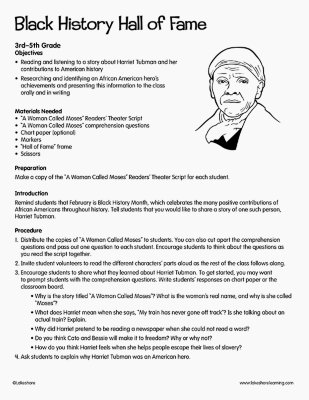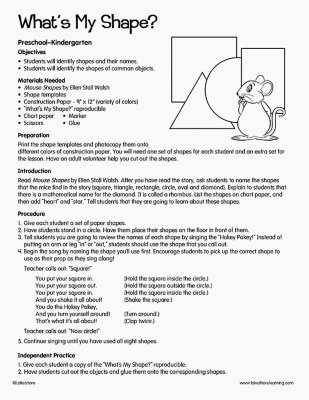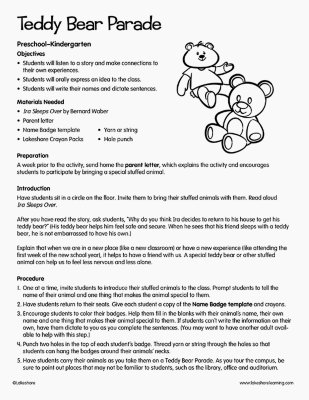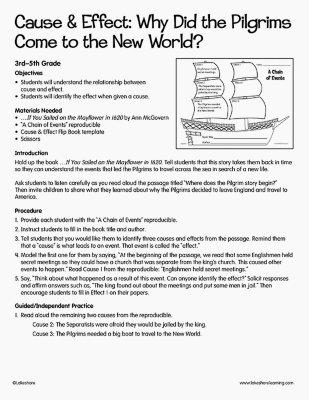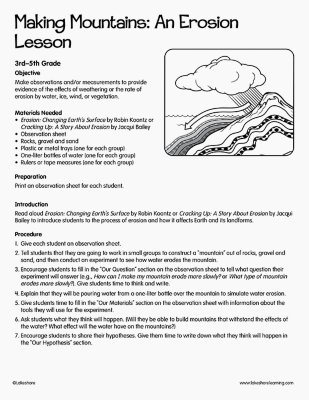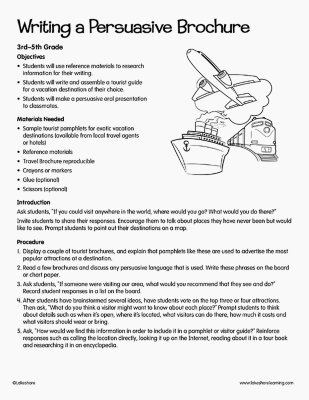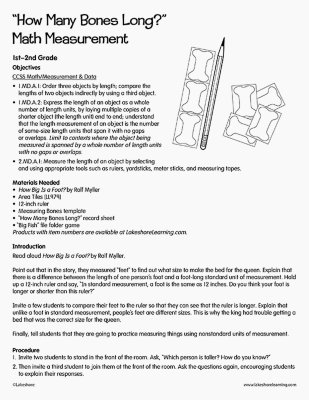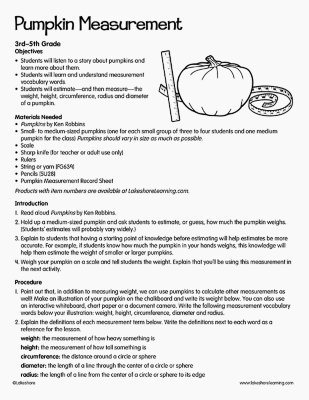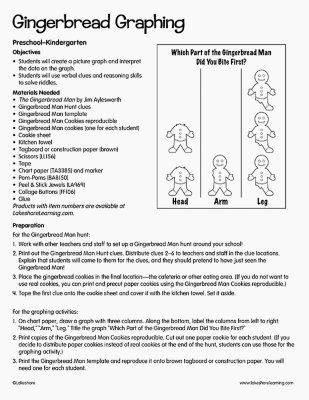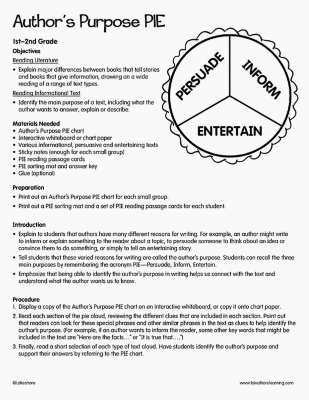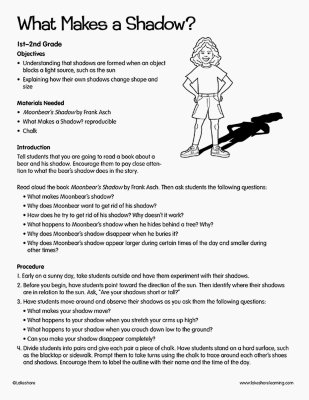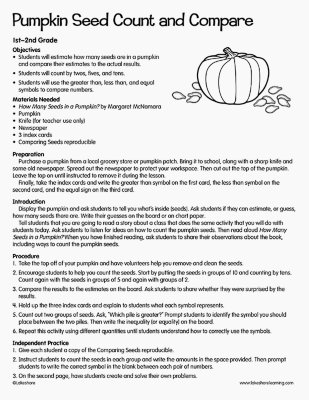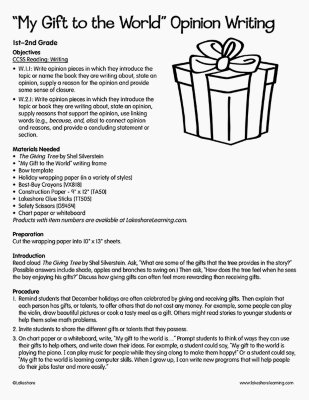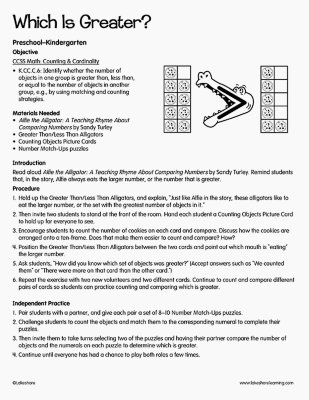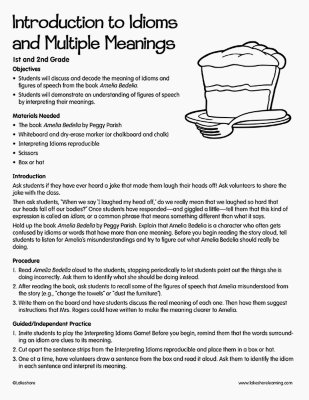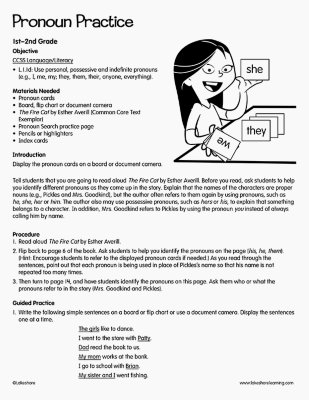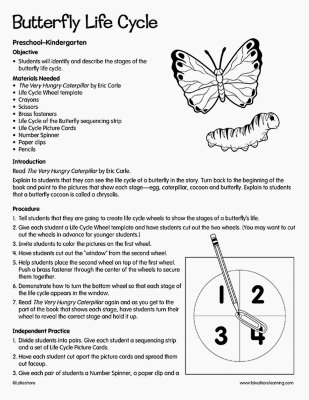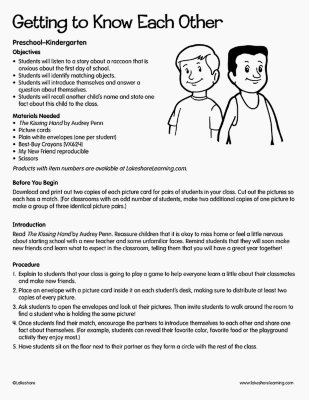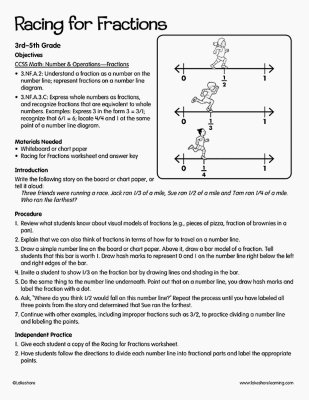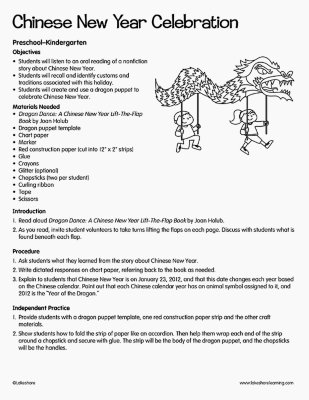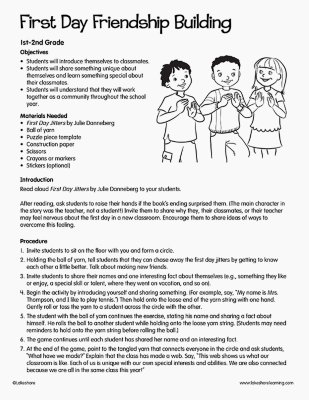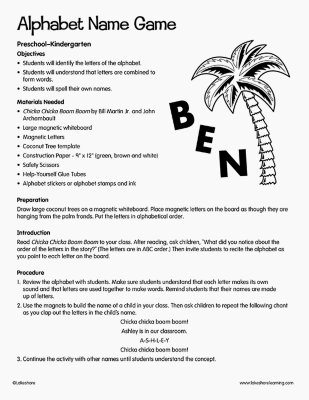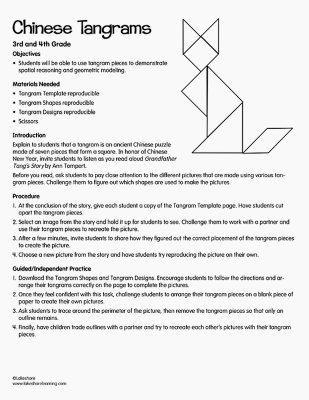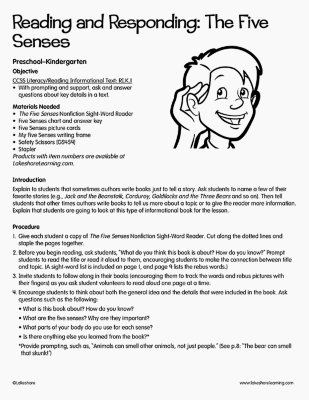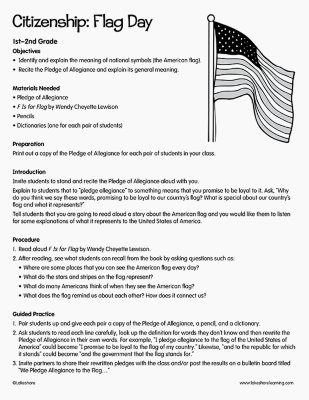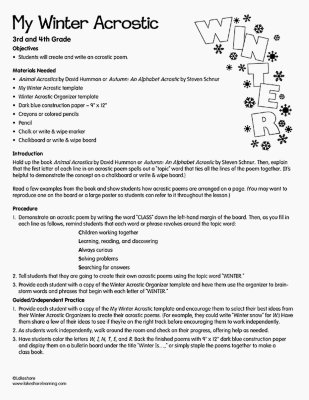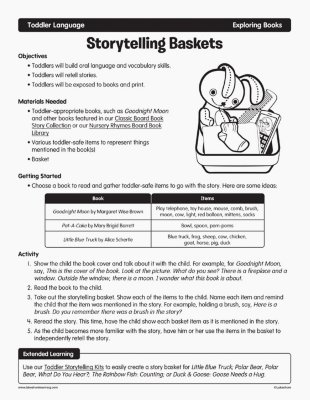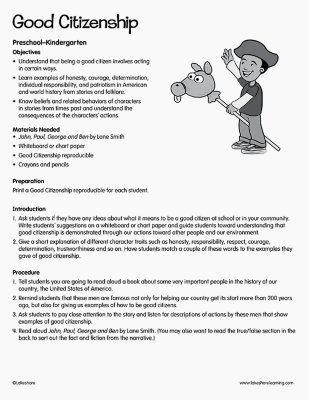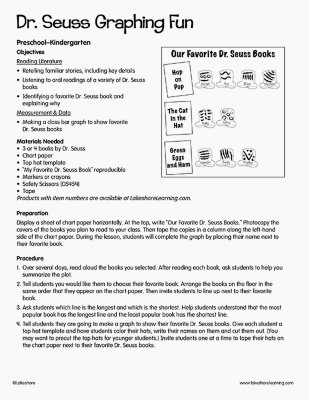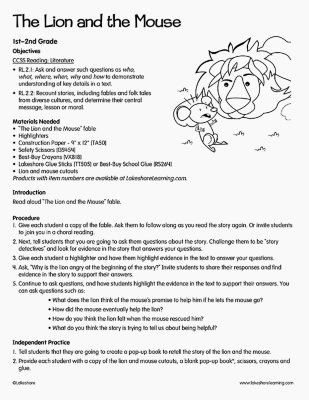Narrow by Grade
Grade
62 results for "story"
ITEMS:
Summarizing a Story
4th Grade
Objectives Students will listen to or read a story. Students will summarize the story in writing, using sequencing words in their summaries. Materials Needed “Found!” reading passage “First Snow” reading passage “Summarize a Story” reproducible Introduction Provide a copy of the “Found!” reading passage to each student. Display the passage on a projector or chart paper. Read the passage aloud and encourage students to read along with you. Tell students that you are going to demonstrate how to summarize the passage. Explain that you will break it down into three parts, describing what happens at the beginning, middle, and end. As you summarize aloud, underline important parts of the story and have students help you determine which events happen first, next, and last. For example, underline the first three sentences and say, “Robby found a wallet full of money that he could use to buy lots of things he wanted. Can anyone point to the sentence that tells what happens next?” (Answer: Suddenly, Robby saw that the wallet had a driver’s license in it with someone’s name and address.) Underline this sentence and offer a short summary, such as, “Robby found out whom the wallet and money belonged to.” Then ask, “In which sentence can we read about what Robby does at the end of the story?” (Answer: Robby wanted to be a good citizen, so he decided to return the wallet and the money.) Draw a line under the last sentence and say, “Robby decides to return the wallet to its owner.” Go over the three parts again so that the summary is very clear: “First, Robby found a wallet with money in it that he wanted to spend. Next, he found a name and address in the wallet. Last, Robby decides to return the wallet and money to its owner.” Invite students to ask questions about the process as you check for understanding.
View Lesson PlanThe Heart of a Story: Characters, Setting and Events
1st Grade - 2nd Grade
Objectives Using illustrations and details in a story to describe its characters, setting or events Using information from illustrations and words to demonstrate understanding of characters, setting or plot Materials Needed Nate the Great and the Mushy Valentine by Marjorie Weinman Sharmat Story Elements chart Chart paper, chalkboard or document camera Marker or chalk Story Elements spinner Story Elements story and questions Pencils Paper clips Introduction Read aloud Nate the Great and the Mushy Valentine by Marjorie Weinman Sharmat.
View Lesson PlanWhat’s Next? Sequencing Story
1st Grade - 2nd Grade
Objectives Reading Literature Retelling stories and demonstrating understanding of the central message or lesson Describing characters, settings, and major events in a story, using key details Understanding and identifying sequence words (e.g., “first,” “next,” “then,” “finally”) Materials Needed Lost in the Fog booklet reproducible Lost in the Fog sequencing mat Lost in the Fog picture and sentence cards Best-Buy Scissors Lakeshore Glue Sticks Pencils Preparation Make a copy of the Lost in the Fog booklet reproducible, sequencing mat, picture cards and sentence cards for each student. Follow the directions to assemble each booklet. Introduction Give each student a booklet and ask students to follow along as you read the story aloud. Explain that authors use words like “first,” “next,” “then” and “finally” to help readers follow the order of events in a story. Challenge students to listen for these words as you read aloud.
View Lesson PlanSame Story, Different Cultures
1st Grade - 2nd Grade
Objectives CCSS Reading: Literature RL.2.1: Ask and answer such questions as who, what, where, when, why, and how to demonstrate understanding of key details in a text. RL.2.2: Recount stories, including fables and folk tales from diverse cultures, and determine their central message, lesson, or moral. RL.2.9: Compare and contrast two or more versions of the same story (e.g., Cinderella stories) by different authors or from different cultures. Materials Needed Any copy of Cinderella A copy of a Cinderella story from another culture, such as Yeh-Shen or The Rough-Face Girl Whiteboard or chart paper “The Tortoise and the Hare” “The Heron and the Hummingbird” Comparing Stories reproducible Introduction Tell students that you are going to read two different stories and then compare them to find similarities and differences. Ask students to pay special attention to the characters, the plot and the lesson that each story teaches.
View Lesson PlanStory Sequencing and Writing
1st Grade - 2nd Grade
Objectives CCSS Language: Writing W.1.3: Write narratives in which they recount two or more appropriately sequenced events, include some details regarding what happened, use temporal words to signal event order, and provide some sense of closure. W.2.3: Write narratives in which they recount a well-elaborated event or short sequence of events, include details to describe actions, thoughts, and feelings, use temporal words to signal event order, and provide a sense of closure. Materials Needed Story Sequencing graphic organizer Storytelling picture cards Scissors Chart paper Introduction Write the words first, then, next and last on chart paper. Point out to the class that these are words that writers often use to indicate the order, or sequence, of events in a story. Within the story, writers will then elaborate on the actions, feelings or thoughts of the characters and provide details about the events.
View Lesson PlanStory Sequencing
Pre-K
Objective CCSS Reading: Literature RL.K.2: With prompting and support, retell familiar stories, including key details. Materials Needed A copy of The Three Little Pigs Story sequence cards for The Three Little Pigs A copy of any other familiar read-aloud Story Sequence reproducible Lakeshore Standard Crayon Packs Chart paper Introduction Read aloud The Three Little Pigs.
View Lesson PlanPass the Story!
2nd Grade
Objective
- Tell a story with appropriate facts and relevant, descriptive details, speaking audibly in sentences.
Story Elements Lesson
1st Grade
Objectives Students will actively listen to a read-aloud selection. Students will extend reading comprehension by identifying the who, what, when, where and why elements of a story. Materials Needed Miss Malarkey Doesn’t Live in Room 10 by Judy Finchler Chalkboard or whiteboard Sentence Strips and marker Pick-A-Question cards or Pick-A-Question Fiction Comprehension Tub Paper and pencils (one for each small group) Pocket chart or digital aids (e.g., interactive whiteboard, document camera, etc.) Introduction Read aloud Miss Malarkey Doesn’t Live in Room 10 by Judy Finchler.
View Lesson PlanCharacter Study and Story Elements Comparison
3rd Grade - 4th Grade
Objectives CCSS Reading/Literature & Writing RL.3.9: Compare and contrast the themes, settings and plots of stories written by the same author about the same or similar characters (e.g., in books from a series). W.3.3: Write narratives to develop real or imagined experiences or events using effective technique, descriptive details and clear event sequences. Materials Needed Lilly’s Purple Plastic Purse by Kevin Henkes Lilly’s Big Day by Kevin Henkes Character Analysis chart Story Elements chart Paper and pencils Introduction Read aloud Lilly’s Purple Plastic Purse and Lilly’s Big Day by Kevin Henkes. Encourage students to discuss Lilly’s character traits in both stories, and have them help you fill in the Character Analysis chart.
View Lesson PlanSnowman Stories
1st Grade
Objectives Students will narrate events of a story based on illustrations. Students will write an imaginative story about a friendship with a snowman. Materials Needed The Snowman by Raymond Briggs Snowman Writing Frame Construction Paper - 9" x 12" (blue) Scissors Glue Introduction Ask students if they have ever made a snowman. (For students in warmer climates, ask if they have seen pictures of snowmen or if they have seen a snowman on vacation.) Have volunteers describe the snowmen they have made or seen. Ask questions to encourage creative and imaginative thinking, such as, “Would you be surprised if you made a snowman that came to life and wanted to play with you? What would you do with the snowman? What would you want to show the snowman? What might the snowman be curious about?”
View Lesson PlanSilly Story Telephone
3rd Grade
Objectives
- Write a caption that matches an illustration.
- Draw a picture that depicts a sentence.
My Awesome, Amazing, Very Good, Super-Great Day Story
3rd Grade - 4th Grade
Objectives Students will listen to, recall and interpret information from literature. Students will make connections to their personal experiences. Students will write a descriptive paragraph. Materials Needed Alexander and the Terrible, Horrible, No Good, Very Bad Day by Judith Viorst Graphic organizer Revising and Editing checklist Introduction Read aloud Alexander and the Terrible, Horrible, No Good, Very Bad Day to your class. After you read, ask students to recall the things that happened to Alexander that added to his terrible, horrible, no good, very bad day. Then ask students to think about what could have happened differently to turn Alexander’s day into an awesome, amazing, very good, super-great day. Invite volunteers to share their responses.
View Lesson PlanName Stories
4th Grade
Objectives
- Celebrate and embrace people’s cultural and ethnic differences.
- Explore and incorporate people’s differences to enrich learning and foster belonging.
Beginning, Middle and End
Pre-K - Kindergarten
Objectives Students will identify the beginning, middle and end of a story. Students will recall events of a story in the correct order. Materials Needed The book The Rainbow Fish by Marcus Pfister Chart paper and marker (or chalkboard and chalk) Construction Paper (12" x 18") Scissors Crayons Aluminum Foil Glue The Rainbow Fish Reproducible Introduction Ask students to raise their hands if they like it when their friends share things with them. Then ask them to raise their hands if they have ever owned something so special that they didn’t want to share it with others. Invite a few volunteers to talk about their prized possession. Finally, ask students, “How do you think your friends would feel if you never shared with them?” and, “How do you think you would feel if your friends didn?t share with you?” Tell students that you are going to read a book called The Rainbow Fish. Explain how the Rainbow Fish in the story has something special that he is not sure he wants to share. Invite students to pay close attention to the sequence of events in the story as you read it aloud. Ask them to think about what happens in the beginning, in the middle and at the end of the story.
View Lesson Plan"Back to School" Poem Booklets: An Introduction to Poems and Storytelling
Kindergarten
Objectives Recognizing common types of texts (e.g., storybooks, poems) Naming the author and illustrator of a story and defining the role of each in telling the story Recognizing and producing rhyming words Materials Needed Over in the Meadow by Olive A. Wadsworth with illustrations by Ezra Jack Keats Whiteboard, overhead projector, document camera or interactive whiteboard “Back to School” poem booklet Crayons Introduction Tell students that you are going to read a picture book called Over in the Meadow. Explain that the words are a poem that was written by author Olive A. Wadsworth. Point to the title page and indicate that the pictures were drawn by Ezra Jack Keats. Explain that adding pictures to the poem can help the reader understand more about what is happening in the story. Explain to students that authors, or writers, often write poems to communicate ideas or tell a whole story. Point out that many poems contain rhyming words and a certain rhythm to their sentences. Ask students to pay special attention to the rhythm of the poem and how some of the words rhyme. As you read, challenge students to find two words in the poem that rhyme.
View Lesson PlanReading Reflections
5th Grade
Objectives CCSS Reading/Literature: RL.4.2, RL.5.2, RL.5.6 Determine a theme of a story, drama or poem from details in the text; summarize the text. Determine a theme of a story, drama or poem from details in the text, including how characters in a story or drama respond to challenges or how the speaker in a poem reflects upon a topic; summarize the text. Describe how a narrator’s or speaker’s point of view influences how events are described. Materials Needed Document camera or whiteboard “Arithmetic” by Carl Sandburg Read and Respond record Introduction Explain to students that, just as an author expresses ideas in the form of a story, a poet expresses thoughts and ideas in the form of a poem. Point out that, while a poem does not always have to rhyme, it consistently expresses a poet’s ideas or thoughts about a topic—often using very little space. Challenge students to listen carefully as you read aloud a poem by Carl Sandburg called “Arithmetic.” Remind students that “arithmetic” is another word for “math.” Ask students to think about what the poet is trying to say and what theme, or “big idea,” he is trying to share about arithmetic/math.
View Lesson PlanMaking Sense of Multiplication
3rd Grade - 4th Grade
Objective Generating a number or shape pattern that follows a given rule Identifying arithmetic patterns and explaining them using properties of operations Materials Needed Anno’s Magic Seeds by Mitsumasa Anno Chart paper or document camera Paper and pencils Perplexing Patterns reproducible and answer key 3-In-A-Row! multiplication cards Two different-colored highlighters for each pair of students in your class Paper clips Introduction Begin reading aloud Anno’s Magic Seeds by Mitsumasa Anno. (You may want to preread the story and place a sticky note on the specific pages the lesson highlights.) When you reach the part in the story where Jack decides to bury two seeds in the ground instead of only one, pause and ask students to predict what might happen the following fall. How many seeds do they think the buried seeds will produce? Ask them to explain why. Then continue reading to find out the answer. Continue reading the story, asking for predictions for the next year and then comparing the students’ predictions to the results in the story.
View Lesson PlanLiteral vs. Nonliteral Meanings
3rd Grade - 4th Grade
Objective CCSS Language/Vocabulary Acquisition and Use: L.3.5.a, L.4.5.b Demonstrate understanding of word relationships and nuances in word meanings: a. Distinguish the literal and nonliteral meanings of words and phrases in context (e.g., take steps). Demonstrate understanding of figurative language, word relationships and nuances in word meanings: b. Recognize and explain the meaning of common idioms. Materials Needed Amelia Bedelia by Peggy Parish Chart paper and marker or chalkboard and chalk or document camera Illustrating Idioms page Wrap-Around Language Idiom cards and answer key Markers or Crayons Best-Buy Scissors Before You Begin Explain to students that words or phrases can have literal or nonliteral meanings. Tell them that a nonliteral meaning is when a phrase means something other than the exact words in it. Explain that authors sometimes use nonliteral meanings in their writing as a way to make a comparison or an exaggerated statement about something. For example, an author writing that someone is a “night owl” is really saying that this person is awake and active at night (nonliteral meaning) rather than stating that the person turns into an animal at night (literal meaning). Tell students that you are going to read the story Amelia Bedelia by Peggy Parish. Ask students to actively listen for the idioms, or nonliteral phrases, that are used in the story. Introduction Begin reading aloud to the class Amelia Bedelia by Peggy Parish. As you read, pause to point out one or two forms of figurative language (e.g., “change the towels” on p. 16 or “draw the drapes” on p. 25) that cause confusion for Amelia. Ask students to explain and describe what they really mean, as opposed to Amelia’s literal interpretation of the phrases. Before you continue with the story, ask students to pay special attention to some of the other forms of figurative language in the story as Amelia encounters them.
View Lesson PlanComparing Living Things
1st Grade
Objectives Students will listen to a story that is read aloud and recall events from the story. Students will understand that trees and other living things have patterns that they follow from one season to the next. Students will learn about hibernation. Students will research different types of animals and compare and contrast the animals. Students will extend their learning by creating a book that illustrates the differences between two animals. Materials Needed Fletcher and the Falling Leaves by Julia Rawlinson Tree Squirrels and Ground Squirrels graphic organizer Bears and Bats graphic organizer Foxes and Rabbits graphic organizer Hamsters and Mice graphic organizer Construction paper (white) Stapler Best-Buy Crayons or Best-Buy Colored Pencils Scissors Preparation Cut the white construction paper into 4.5" x 6.5" rectangles. Staple six to eight rectangles together to make booklets for the class. (You will need four booklets for four groups of student researchers.) Make several copies of each graphic organizer. Introduction Invite students to gather on the floor in front of you as you read aloud Fletcher and the Falling Leaves by Julia Rawlinson. Ask students the following questions: What is Fletcher’s problem in the story? (Answer: Fletcher was sad that the leaves were disappearing from the tree. He did not understand that the leaves were falling off the tree in preparation for winter.) What does Fletcher discover when he goes to visit the tree at the end of the story? (Answer: It is covered with shimmering icicles and is just as beautiful as it was before.)
View Lesson PlanMultistep Word Problems
3rd Grade
Objectives CCSS Math: Operations & Algebraic Thinking 3.OA.D.8: Solve two-step word problems using the four operations. Represent these problems using equations with a letter standing for the unknown quantity. Assess the reasonableness of answers using mental computation and estimation strategies including rounding. 4.OA.A.3: Solve multistep word problems posed with whole numbers and having whole-number answers using the four operations, including problems in which remainders must be interpreted. Represent these problems using equations with a letter standing for the unknown quantity. Assess the reasonableness of answers using mental computation and estimation strategies including rounding. Materials Needed Cardboard box or posterboard, cut into an outline of a bus (optional) Whiteboard or chart paper Tim’s Yard Work flyer Neighborhood Jobs reproducible Neighborhood Jobs Answer Key Preparation Print out a copy of the Tim’s Yard Work flyer and the Neighborhood Jobs reproducible for each student in your class. (You can also display the flyer on a document camera.) Introduction Instruct students to listen very carefully to the following story problem: Mr. Smith is driving a bus. At first, the bus has no passengers. At the first stop, 10 passengers get onto the bus. At the second stop, 2 passengers get off the bus. Then 4 passengers board the bus. At the third stop, half the passengers get off the bus. Pause for a few seconds. Then ask, “Now...what is the name of the bus driver?” Most students will likely react with surprise at this question, but a few will remember that you stated who was driving the bus at the beginning of the story problem. Affirm that the name of the bus driver is Mr. Smith. Ask students to raise their hands if they were calculating the number of passengers getting on and off the bus. Explain that, although this story problem was a riddle with a surprising twist at the end, those with their hands raised were actually calculating a multistep math problem that involved addition, subtraction and even division. Point out that this exercise is also a good example of why it is helpful to read the whole problem first in order to find out what information is needed to answer the question.
View Lesson PlanExploring Nonfiction Text
4th Grade
Objectives CCSS Reading: Reading Informational Text RI.1.7: Use the illustrations and details in a text to describe its key ideas. RI.2.7: Explain how specific images (e.g., a diagram showing how a machine works) contribute to and clarify a text. Materials Needed Ah, Music! by Aliki Selection of one or two fiction read-alouds “The Venus Flytrap” reading selection Chart paper Introduction Ask students to tell you what the difference is between fiction and nonfiction text. (Help students understand that fiction is not real or not a true story that happened in real life, and nonfiction is factual or real.) Show students a sample of fiction (e.g., a fiction read-aloud, such as Corduroy by Don Freeman; The Rainbow Fish by Marcus Pfister; or Alexander and the Terrible, Horrible, No Good, Very Bad Day by Judith Viorst). Ask, “When we read a fiction story like this one, what do the pictures show us?” (Encourage students to share their responses, guiding them to understand that the illustrations usually give a snapshot or visual image of what is happening in the story.) Then hold up the book Ah, Music! by Aliki, and tell students, “In nonfiction texts, you might find pictures, too! These pictures will help us understand what the words are telling us. There might also be a diagram that shows us more details about the information.”
View Lesson PlanWild About Word Problems
1st Grade - 2nd Grade
Objectives CCSS Math/Operations and Algebraic Thinking: 1.OA.1, 1.OA.2 Use addition and subtraction within 20 to solve word problems involving situations of adding to, taking from, putting together, taking apart, and comparing with unknowns in all positions by using objects, drawings, and equations with a symbol for the unknown number to represent the problem. Solve word problems that call for addition of three whole numbers whose sum is less than or equal to 20 by using objects, drawings, and situations with a symbol for the unknown number to represent the problem. Materials Needed Animals on Board by Stuart J. Murphy Wild Animal Counters or other animal manipulatives Animal Story Problems and answer key Create-Your-Own Animal Story Problems Easel, document camera, chart paper, chalkboard or whiteboard [to display problems] Introduction Read aloud Animals on Board by Stuart J. Murphy. As you read, encourage students to help you solve the word problems that are presented in the story. Then point out how the problems are represented in numeric form to show the sum. For example, you might say, “There were three tigers. Along came two more. 3 + 2 = how many?”
View Lesson PlanFamiliar Storytelling
Kindergarten
Objectives CCSS Reading/Literature: RL.K.2, RL.K.3 With prompting and support, retell familiar stories, including key details. With prompting and support, identify characters, settings and major events in a story. Materials Needed Goldilocks and the Three Bears by Caralyn Buehner or The Three Bears by Paul Galdone Retelling a Story chart Goldilocks and the Three Bears finger-puppet cutouts Goldilocks and the Three Bears storyboard page Tape Chart Paper and marker or document camera or whiteboard Safety Scissors Best-Buy Crayons Recycled gloves (with finger sections) and Glue (optional) Other fairy tales and folk tales Storytelling Glove and Three Bears Storytelling Puppets (optional) Introduction Read aloud Goldilocks and the Three Bears by Caralyn Buehner or The Three Bears by Paul Galdone. As you read aloud, stop during parts of the text and point out specific story elements and details—such as the setting, the sizes of the bears, the description of Goldilocks and so on.
View Lesson PlanTeaching Tangrams
2nd Grade
Objectives Students will identify and compare 2-D shapes. Students will understand the difference between congruent and similar shapes. Students will create and extend patterns. Students will combine shapes to create new shapes. Materials Needed Grandfather Tang’s Story: A Tale Told with Tangrams by Ann Tompert Tangrams template or Tangrams Tangram picture-matching cards or Tangram Picture Matching Cards Pattern blocks template or Pattern Blocks “Shapes Gallery” activity mat Scissors Paper & pencils Preparation: Print and copy the tangrams template, tangram picture-matching cards, pattern blocks template and “Shapes Gallery” activity mat. You will need one copy of each for each student. You can cut out the tangram shapes and pattern blocks in advance, or have students cut them out during the lesson. (You also can use the Pattern Blocks, Tangrams and Tangram Picture Matching Cards for this lesson.) Introduction Read aloud Grandfather Tang’s Story: A Tale Told with Tangrams. Show students the seven tangram shapes (two small triangles, two large triangles, one medium triangle, one square and one parallelogram). Tell students that tangrams originated in China. The story introduced only a few of the many shapes and figures that can be made with tangrams.
View Lesson PlanEarth Day Every Day
3rd Grade - 5th Grade
Objectives Students will analyze the characters and events in The Lorax by Dr. Seuss, drawing comparisons between the fictitious environment and our own environment. Students will discuss ways to positively impact the environment. Materials Needed The Lorax by Dr. Seuss Small-Group Discussion Questions Colored pencils, pens or markers Introduction Discuss the meaning of Earth Day, and introduce the book to students. Explain that aside from being an enjoyable children’s story, The Lorax is a metaphor to make us think about the world around us and the impact we have on our environment. Invite students to listen carefully to the story and see if they can draw comparisons between the characters and events in the story and our own planet.
View Lesson PlanParts of a Plant
Kindergarten
Objectives Students will identify the parts of a plant and how plants grow. Students will determine what plants need to survive. Materials Needed Package of carrot seeds The Carrot Seed by Ruth Krauss Parts of a Plant Diagram Parts of a Plant Activity Sheet Scissors Crayons Glue Introduction Gather children together for circle time and give one carrot seed to each child. (Don’t tell them what kind of seed it is!) Ask them to share their thoughts on what the seed will turn into after it is planted. Encourage them to make as many guesses as they want to. Tell students you are going to read a story about a boy who has the same kind of seed they are holding. Invite them to pay close attention to how the seed changes throughout the story and what the boy does to help it grow. Encourage students to listen carefully as you read to find out what kind of seed it is!
View Lesson PlanNew Year’s Resolution
1st Grade
Objectives Reading Literature Asking and answering questions about key details in a text Language Producing and expanding complete simple and compound declarative, interrogative, imperative, and exclamatory sentences Defining “New Year’s resolution” and helping to make appropriate class resolutions Writing Creating individual New Year’s resolutions Materials Needed Squirrel’s New Year’s Resolution by Pat Miller Chart paper or whiteboard New Year’s Resolution reproducible Tagboard Self-adhesive magnetic strips Safety Scissors Crayons or markers Glue Introduction Ask students to raise their hands if they have heard of making a New Year’s resolution. Invite them to share what they think a resolution is. Explain that you are going to read aloud a make-believe story about a squirrel who makes a New Year’s resolution. Ask students to pay special attention to the story to find out what a resolution is and why people might make them at the beginning of each year.
View Lesson PlanFun in the Snow
1st Grade - 2nd Grade
Objective Students will recall and reference events in a story. Students will use oral and written language to describe winter activities. Students will draw a picture of their favorite winter activity and write a sentence about it. Materials Needed The Snowy Day by Ezra Jack Keats Chalk or write & wipe marker Chalkboard or write & wipe board Fun in the Snow Worksheet Crayons or colored pencils Introduction Tell students that you are going to read them a story about a boy and what he does on a snowy winter day. Ask them if they have ever played in the snow. If so, have them share what they did. (If you live where it snows every winter, simply have your students share which snow activities they enjoy the most. If you have students who have rarely or never seen snow, ask them what snow activities they think might be fun.)
View Lesson PlanEveryday Learning Activities
Pre-K
Everyday Learning Activities
- When reading a familiar book with your child, encourage your child to use the pictures to “read” parts of the story to you. Afterward, ask your child what happened at the beginning of the story, in the middle, and at the end.
Shape Study
Kindergarten
Objectives CCSS Math/Geometry: K.G.1, K.G.2, K.G.3 Identify and describe shapes (squares, circles, triangles, rectangles, hexagons, cubes, cones, cylinders and spheres). Describe objects in the environment using the names of shapes, and describe the relative positions of these objects using terms such as above, below, beside, in front of, behind and next to. Correctly name shapes regardless of their orientations or overall size. Identify shapes as two-dimensional (lying in a plane, “flat”) or three-dimensional (“solid”). Materials Needed Mouse Shapes by Ellen Stoll Walsh Shape Hunt recording sheets Document camera or whiteboard (optional) Safety Scissors Lakeshore Jumbo Glue Sticks Shapes template Construction Paper (white and a variety of colors) 3-D Geometric Shapes Tub Attribute Blocks Shape & picture cards Shape sorting mat Zip-close plastic bags Pencils Preparation Print out several copies of the shapes template onto different colors of construction paper. (You may also want to cut out the shapes ahead of time for younger students.) Print out copies (either double-sided or on separate sheets) of the Shape Hunt recording sheets for each student. Introduction Read aloud Mouse Shapes by Ellen Stoll Walsh. Ask students to describe what the mice in the story did with the shapes. Have students point back to the story for examples of shapes used to make the objects that the mice hid from the cat.
View Lesson PlanCharacter Building: Bullying
3rd Grade - 5th Grade
Objectives Students will listen and respond to literature read aloud by the teacher. Students will share interpretations of lessons in a story and learn to apply these lessons to their own lives. Materials Needed A Bad Case of Stripes by David Shannon Chalkboard, sentence strips or interactive whiteboard Notebook paper Introduction Ask students if they have a favorite food that might surprise others, like broccoli, spinach or beets! Invite volunteers to tell the class what this surprising food is. Tell students that you are going to read a story in which the main character has an odd choice for a favorite food. Ask students to pay special attention to what happens to this character, how her classmates react to her, and what she does to solve her problem. Read aloud A Bad Case of Stripes by David Shannon.
View Lesson PlanBlack History Hall of Fame
3rd Grade - 5th Grade
Objectives Reading and listening to a story about Harriet Tubman and her contributions to American history Researching and identifying an African American hero’s achievements and presenting this information to the class orally and in writing Materials Needed “A Woman Called Moses” Readers’ Theater Script “A Woman Called Moses” comprehension questions Chart paper (optional) Markers “Hall of Fame” frame Scissors Preparation Make a copy of the “A Woman Called Moses” Readers’ Theater Script for each student. Introduction Remind students that February is Black History Month, which celebrates the many positive contributions of African Americans throughout history. Tell students that you would like to share a story of one such person, Harriet Tubman.
View Lesson PlanWhat’s My Shape
Pre-K - Kindergarten
Objectives Students will identify shapes and their names. Students will identify the shapes of common objects. Materials Needed Mouse Shapes by Ellen Stoll Walsh Shape templates Construction Paper - 9" x 12" (variety of colors) “What’s My Shape?” reproducible Chart paper Scissors Marker glue Preparation: Print the shape templates and photocopy them onto different colors of construction paper. You will need one set of shapes for each student and an extra set for the lesson. Have an adult volunteer help you cut out the shapes. Introduction Read Mouse Shapes by Ellen Stoll Walsh. After you have read the story, ask students to name the shapes that the mice find in the story (square, triangle, rectangle, circle, oval and diamond). Explain to students that there is a mathematical name for the diamond. It is called a rhombus. List the shapes on chart paper, and then add “heart” and “star.” Tell students that they are going to learn about these shapes.
View Lesson PlanTeddy Bear Parade
Pre-K
Objectives Students will listen to a story and make connections to their own experiences. Students will orally express an idea to the class. Students will write their names and dictate sentences. Materials Needed Ira Sleeps Over by Bernard Waber Parent letter Name Badge template Yarn or string Lakeshore Crayon Packs Hole punch Preparation: A week prior to the activity, send home the parent letter, which explains the activity and encourages students to participate by bringing a special stuffed animal. Introduction Have students sit in a circle on the floor. Invite them to bring their stuffed animals with them. Read aloud Ira Sleeps Over. After you have read the story, ask students, “Why do you think Ira decides to return to his house to get his teddy bear?” (His teddy bear helps him feel safe and secure. When he sees that his friend sleeps with a teddy bear, he is not embarrassed to have his own.) Explain that when we are in a new place (like a new classroom) or have a new experience (like attending the first week of the new school year), it helps to have a friend with us. A special teddy bear or other stuffed animal can help us to feel less nervous and less alone.
View Lesson PlanCause & Effect: Why Did the Pilgrims Come to the New World?
3rd Grade
Objectives Students will understand the relationship between cause and effect. Students will identify the effect when given a cause. Materials Needed …If You Sailed on the Mayflower in 1620 by Ann McGovern “A Chain of Events” reproducible Cause & Effect Flip Book template Scissors Introduction Hold up the book …If You Sailed on the Mayflower in 1620. Tell students that this story takes them back in time so they can understand the events that led the Pilgrims to travel across the sea in search of a new life. Ask students to listen carefully as you read aloud the passage titled “Where does the Pilgrim story begin?” Then invite children to share what they learned about why the Pilgrims decided to leave England and travel to America.
View Lesson PlanMaking Mountains: An Erosion Lesson
4th Grade
Objective Make observations and/or measurements to provide evidence of the effects of weathering or the rate of erosion by water, ice, wind, or vegetation. Materials Needed Erosion: Changing Earth’s Surface by Robin Koontz or Cracking Up: A Story About Erosion by Jacqui Bailey Observation sheet Rocks, gravel and sand Plastic or metal trays (one for each group) One-liter bottles of water (one for each group) Rulers or tape measures (one for each group) Introduction Read aloud Erosion: Changing Earth’s Surface by Robin Koontz or Cracking Up: A Story About Erosion by Jacqui Bailey to introduce students to the process of erosion and how it affects Earth and its landforms.
View Lesson PlanWriting a Persuasive Brochure
3rd Grade - 5th Grade
Objectives Using reference materials to research for their writing Introducing the topic or text they are writing about, stating an opinion and creating an organizational structure that lists reasons Providing reasons that support the opinion Reporting on a topic or text, telling a story, or recounting an experience in an organized manner, using appropriate facts and relevant, descriptive details to support main ideas or themes; speaking clearly at an understandable pace Materials Needed Sample tourist pamphlets for exotic vacation destinations (available from local travel agents or hotels) Reference materials Travel Brochure reproducible Crayons or markers Glue (optional) Scissors (optional) Introduction Ask students, “If you could visit anywhere in the world, where would you go? What would you do there?” Invite students to share their responses. Encourage them to talk about places they have never been but would like to see. Prompt students to point out their destinations on a map.
View Lesson Plan"How Many Bones Long?" Math Measurement
1st Grade - 2nd Grade
Objectives CCSS Math/Measurement & Data 1.MD.A.1: Order three objects by length; compare the lengths of two objects indirectly by using a third object. 1.MD.A.2: Express the length of an object as a whole number of length units, by laying multiple copies of a shorter object (the length unit) end to end; understand that the length measurement of an object is the number of same-size length units that span it with no gaps or overlaps. Limit to contexts where the object being measured is spanned by a whole number of length units with no gaps or overlaps. 2.MD.A.1: Measure the length of an object by selecting and using appropriate tools such as rulers, yardsticks, meter sticks, and measuring tapes. Materials Needed How Big Is a Foot? by Rolf Myller Area Tiles 12-inch ruler Measuring Bones template “How Many Bones Long?” record sheet “Big Fish” file folder game Introduction Read aloud How Big Is a Foot? by Rolf Myller. Point out that in the story, they measured “feet” to find out what size to make the bed for the queen. Explain that there is a difference between the length of one person’s foot and a foot-long standard unit of measurement. Hold up a 12-inch ruler and say, “In standard measurement, a foot is the same as 12 inches. Do you think your foot is longer or shorter than this ruler?” Invite a few students to compare their feet to the ruler so that they can see that the ruler is longer. Explain that unlike a foot in standard measurement, people’s feet are different sizes. This is why the king had trouble getting a bed that was the correct size for the queen. Finally, tell students that they are going to practice measuring things using nonstandard units of measurement.
View Lesson PlanPumpkin Measurement
3rd Grade
Objectives Students will listen to a story about pumpkins and learn more about them. Students will learn and understand measurement vocabulary words. Students will estimate—and then measure—the weight, height, circumference, radius and diameter of a pumpkin. Materials Needed Pumpkins by Ken Robbins Small- to medium-sized pumpkins (one for each small group of three to four students and one medium pumpkin for the class) Pumpkins should vary in size as much as possible. Scale Sharp knife (for teacher or adult use only) Rulers String or yarn Pencils Pumpkin Measurement Record Sheet Introduction Read aloud Pumpkins by Ken Robbins. Hold up a medium-sized pumpkin and ask students to estimate, or guess, how much the pumpkin weighs. (Students’ estimates will probably vary widely.) Explain to students that having a starting point of knowledge before estimating will help estimates be more accurate. For example, if students know how much the pumpkin in your hands weighs, this knowledge will help them estimate the weight of smaller or larger pumpkins. Weigh your pumpkin on a scale and tell students the weight. Explain that you’ll be using this measurement in the next activity.
View Lesson PlanGingerbread Graphing
Pre-K
Objectives Students will create a picture graph and interpret the data on the graph. Students will use verbal clues and reasoning skills to solve riddles. Materials Needed The Gingerbread Man by Jim Aylesworth Gingerbread Man Hunt clues Gingerbread Man template Gingerbread Man Cookies reproducible Scissors Gingerbread Man cookies (one for each student) Cookie sheet Kitchen towel Tagboard or construction paper (brown) Tape Chart paper and marker Pom-Poms Peel & Stick Jewels Collage Buttons Glue Preparation: For the Gingerbread Man hunt: Work with other teachers and staff to set up a Gingerbread Man hunt around your school! Print out the Gingerbread Man Hunt clues. Distribute clues 2 - 6 to the teachers and staff in the clue locations. Explain that students will come to them for the clues, and they should pretend to have just seen the Gingerbread Man! Place the gingerbread cookies in the final location—the cafeteria or other eating area. (If you do not want to use real cookies, you can print and precut paper cookies using the Gingerbread Man Cookies reproducible.) Tape the first clue onto the cookie sheet and cover it with the kitchen towel. Set it aside. For the graphing activities: On chart paper, draw a graph with three columns. Along the bottom, label the columns from left to right: “Head,” “Arm,” and “Leg.” Title the graph “Which Part of the Gingerbread Man Did You Bite First?” Print copies of the Gingerbread Man Cookies reproducible. Cut out one paper cookie for each student. (If you decide to distribute paper cookies instead of real cookies at the end of the hunt, students can use those for the graphing activity.) Print the Gingerbread Man template and reproduce it onto brown tagboard or construction paper. You will need one for each student. Introduction Read aloud The Gingerbread Man by Jim Aylesworth. After the story, tell students that you have prepared a Gingerbread Man cookie for them to eat. (If you are not using real cookies, tell students you have made a paper cookie for them to use in a special math project.) Then take out the covered cookie sheet and pull off the towel. Act surprised as you announce, “Oh no, our Gingerbread Man has run away! Look, he left a note for us to read!” Read the clue aloud to students.
View Lesson PlanAuthor’s Purpose PIE
1st Grade
Objectives Reading Literature Explain major differences between books that tell stories and books that give information, drawing on a wide reading of a range of text types. Reading Informational Text Identify the main purpose of a text, including what the author wants to answer, explain or describe. Materials Needed Author’s Purpose PIE chart Interactive whiteboard or chart paper Various informational, persuasive and entertaining texts Sticky notes (enough for each small group) PIE reading passage cards PIE sorting mat and answer key Glue (optional) Introduction Explain to students that authors have many different reasons for writing. For example, an author might write to inform or explain something to the reader about a topic, to persuade someone to think about an idea or convince them to do something, or simply to tell an entertaining story. Tell students that these varied reasons for writing are called the author’s purpose. Students can recall the three main purposes by remembering the acronym PIE—Persuade, Inform, Entertain. Emphasize that being able to identify the author’s purpose in writing helps us connect with the text and understand what the author wants us to know.
View Lesson PlanWhat Makes a Shadow?
1st Grade
Objectives Understanding that shadows are formed when an object blocks a light source, such as the sun Explaining how their own shadows change shape and size Materials Needed Moonbear’s Shadow by Frank Asch What Makes a Shadow? reproducible Chalk Introduction Tell students that you are going to read a book about a bear and his shadow. Encourage them to pay close attention to what the bear’s shadow does in the story. Read aloud the book Moonbear’s Shadow by Frank Asch. Then ask students the following questions: What makes Moonbear’s shadow? Why does Moonbear want to get rid of his shadow? How does he try to get rid of his shadow? Why doesn’t it work? What happens to Moonbear’s shadow when he hides behind a tree? Why? Why does Moonbear’s shadow disappear when he buries it? Why does Moonbear’s shadow appear larger during certain times of the day and smaller during other times?
View Lesson PlanPumpkin Seed Count and Compare
1st Grade - 2nd Grade
Objectives Students will estimate how many seeds are in a pumpkin and compare their estimates to the actual results. Students will count by twos, fives, and tens. Students will use the greater than, less than and equal symbols to compare numbers. Materials Needed How Many Seeds in a Pumpkin? by Margaret McNamara Pumpkin Knife (for teacher use only) Newspaper 3 index cards Comparing Seeds reproducible Preparation: Purchase a pumpkin from a local grocery store or pumpkin patch. Bring it to school, along with a sharp knife and some old newspaper. Spread out the newspaper to protect your workspace. Then cut out the top of the pumpkin. Leave the top on until instructed to remove it during the lesson. Finally, take the index cards and write the greater than symbol on the first card, the less than symbol on the second card, and the equal sign on the third card. Introduction Display the pumpkin and ask students to tell you what’s inside (seeds). Ask students if they can estimate, or guess, how many seeds there are. Write their guesses on the board or on chart paper. Tell students that you are going to read a story about a class that does the same activity that you will do with students today. Ask students to listen for ideas on how to count the pumpkin seeds. Then read aloud How Many Seeds in a Pumpkin? When you have finished reading, ask students to share their observations about the book, including ways to count the pumpkin seeds.
View Lesson PlanMy Gift to the World Opinion Writing
1st Grade - 2nd Grade
Objectives CCSS Reading: Writing W.1.1: Write opinion pieces in which they introduce the topic or name the book they are writing about, state an opinion, supply a reason for the opinion and provide some sense of closure. W.2.1: Write opinion pieces in which they introduce the topic or book they are writing about, state an opinion, supply reasons that support the opinion, use linking words (e.g., because, and, also) to connect opinion and reasons, and provide a concluding statement or section. Materials Needed The Giving Tree by Shel Silverstein “My Gift to the World” writing frame Bow template Holiday wrapping paper (in a variety of styles) Best-Buy Crayons Construction Paper - 9" x 12" Lakeshore Glue Sticks Safety Scissors Chart paper or whiteboard Preparation: Cut the wrapping paper into 10" x 13" sheets. Introduction Read The Giving Tree by Shel Silverstein. Ask, “What are some of the gifts that the tree provides in the story?” (Possible answers include shade, apples and branches to swing on.) Then ask, “How does the tree feel when he sees the boy enjoying his gifts?” Discuss how giving gifts can often feel more rewarding than receiving gifts.
View Lesson PlanWhich Is Greater?
Kindergarten
Objective CCSS Math: Counting & Cardinality K.CC.C.6: Identify whether the number of objects in one group is greater than, less than, or equal to the number of objects in another group, e.g., by using matching and counting strategies. Materials Needed Alfie the Alligator: A Teaching Rhyme About Comparing Numbers by Sandy Turley Greater Than/Less Than Alligators Counting Objects Picture Cards Number Match-Ups puzzles Introduction Read aloud Alfie the Alligator: A Teaching Rhyme About Comparing Numbers by Sandy Turley. Remind students that, in the story, Alfie always eats the larger number, or the number that is greater.
View Lesson PlanIntroduction to Idioms and Multiple Meanings
1st Grade
Objectives Students will discuss and decode the meaning of idioms and figures of speech from the book Amelia Bedelia. Students will demonstrate an understanding of figures of speech by interpreting their meanings. Materials Needed The book Amelia Bedelia by Peggy Parish Whiteboard and dry-erase marker (or chalkboard and chalk) Interpreting Idioms Reproducible Scissors Box or hat Introduction Ask students if they have ever heard a joke that made them laugh their heads off! Ask volunteers to share the joke with the class. Then ask students, “When we say ‘I laughed my head off,’ do we really mean that we laughed so hard that our heads fall off our bodies?” Once students have responded—and giggled a little—tell them that this kind of expression is called an idiom, or a common phrase that means something different than what it says. Hold up the book Amelia Bedelia by Peggy Parish. Explain that Amelia Bedelia is a character who often gets confused by idioms or words that have more than one meaning. Before you begin reading the story aloud, tell students to listen for Amelia’s misunderstandings and try to figure out what Amelia Bedelia should really be doing.
View Lesson PlanFamily Interview
4th Grade
Objectives
- Develop an understanding of and appreciation for different cultures.
- Report on a topic or text, tell a story, or recount an experience in an organized manner.
Pronoun Practice
1st Grade - 2nd Grade
Use personal, possessive and indefinite pronouns (e.g., I, me, my, they, them, their, anyone, everything). Materials Needed: pronoun cards, board, flip chart or document camera; The Fire Cat by Esther Averill; Pronoun Search practice page; pencils or highlighters; index cards. Introduction: Display the pronoun cards on a board or document camera. Tell students that you are going to read aloud The Fire Cat by Esther Averill. Before you read, ask students to help you identify different pronouns as they come up in the story. Explain that the names of the characters are proper nouns (e.g., Pickles and Mrs. Goodkind), but the author often refers to them again by using pronouns, such as he, she, her or him. The author also may use possessive pronouns, such as hers or his, to explain that something belongs to a character. In addition, Mrs. Goodkind refers to Pickles by using the pronoun you instead of always calling him by name.
View Lesson PlanButterfly Life Cycle
Pre-K
Objective Students will identify and describe the stages of the butterfly life cycle. Materials Needed The Very Hungry Caterpillar by Eric Carle Life Cycle Wheel template Crayons Scissors Brass fasteners Life Cycle of the Butterfly sequencing strip Life Cycle Picture Cards Number Spinner Paper clips Pencils Introduction Read The Very Hungry Caterpillar by Eric Carle. Explain to students that they can see the life cycle of a butterfly in the story. Turn back to the beginning of the book and point to the pictures that show each stage—egg, caterpillar, cocoon and butterfly. Explain to students that a butterfly cocoon is called a chrysalis.
View Lesson PlanGetting to Know Each Other
Pre-K - Kindergarten
Objectives Students will listen to a story about a raccoon that is anxious about the first day of school. Students will identify matching objects. Students will introduce themselves and answer a question about themselves. Students will recall another child’s name and state one fact about this child to the class. Materials Needed The Kissing Hand by Audrey Penn Picture cards Plain white envelopes (one per student) Best-Buy Crayons My New Friend reproducible Scissors Before You Begin Download and print out two copies of each picture card for pairs of students in your class. Cut out the pictures so each has a match. (For classrooms with an odd number of students, make two additional copies of one picture to make a group of three identical picture pairs.) Introduction Read The Kissing Hand by Audrey Penn. Reassure children that it is okay to miss home or feel a little nervous about starting school with a new teacher and some unfamiliar faces. Remind students that they will soon make new friends and learn what to expect in the classroom, telling them that you will have a great year together!
View Lesson PlanRacing for Fractions
3rd Grade
Objectives CCSS Math: Number & Operations—Fractions 3.NF.A.2: Understand a fraction as a number on the number line; represent fractions on a number line diagram. 3.NF.A.3.C: Express whole numbers as fractions, and recognize fractions that are equivalent to whole numbers. Examples: Express 3 in the form 3 = 3/1; recognize that 6/1 = 6; locate 4/4 and 1 at the same point of a number line diagram. Materials Needed Whiteboard or chart paper Racing for Fractions worksheet and answer key Introduction Write the following story on the board or chart paper, or tell it aloud: Three friends were running a race. Jack ran 1/3 of a mile, Sue ran 1/2 of a mile and Tam ran 1/4 of a mile. Who ran the farthest?
View Lesson PlanChinese New Year Celebration
Pre-K - 1st Grade
Objectives Students will listen to an oral reading of a nonfiction story about Chinese New Year. Students will recall and identify customs and traditions associated with this holiday. Students will create and use a dragon puppet to celebrate Chinese New Year. Materials Needed Dragon Dance: A Chinese New Year Lift-The-Flap Book by Joan Holub Dragon puppet template Chart paper Marker Red construction paper (cut into 12" x 2" strips) Glue Crayons Glitter (optional) Chopsticks (two per student) Curling ribbon Tape Scissors Introduction Read aloud Dragon Dance: A Chinese New Year Lift-the-Flap Book by Joan Holub. As you read, invite student volunteers to take turns lifting the flaps on each page. Discuss with students what is found beneath each flap.
View Lesson PlanFirst Day Friendship Building
1st Grade
Objectives Introducing themselves to classmates Sharing something unique about themselves and learning something special about their classmates Understanding that they will work together as a community throughout the school year Describing people, places, things and events with relevant details, expressing ideas and feelings clearly Materials Needed First Day Jitters by Julie Danneberg Ball of yarn Puzzle piece template Construction paper (white) Scissors Crayons or markers Stickers (optional) Introduction Read aloud First Day Jitters by Julie Danneberg to your students. After reading, ask students to raise their hands if the book’s ending surprised them. (The main character in the story was the teacher, not a student!) Invite them to share why they, their classmates, or their teacher may feel nervous about the first day in a new classroom. Encourage them to share ideas of ways to overcome this feeling.
View Lesson PlanAlphabet Name Game
Pre-K - Kindergarten
Objectives Students will identify the letters of the alphabet. Students will understand that letters are combined to form words. Students will spell their own names. Materials Needed Chicka Chicka Boom Boom by Bill Martin Jr. and John Archambault Large magnetic whiteboard Magnetic Letters Coconut Tree template Construction Paper - 9" x 12" (green, brown and white) Safety Scissors Help-Yourself Glue Tubes Alphabet stickers or alphabet stamps and ink Preparation: Draw large coconut trees on a magnetic whiteboard. Place magnetic letters on the board as though they are hanging from the palm fronds. Put the letters in alphabetical order. Introduction Read Chicka Chicka Boom Boom to your class. After reading, ask children, “What did you notice about the order of the letters in the story?” (The letters are in ABC order.) Then invite students to recite the alphabet as you point to each letter on the board.
View Lesson PlanChinese Tangrams
3rd Grade
Objective Students will be able to use tangram pieces to demonstrate spatial reasoning and geometric modeling. Materials Needed Tangram Template Reproducible Tangram Shapes Reproducible Tangram Designs Reproducible Scissors Introduction Explain to students that a tangram is an ancient Chinese puzzle made of seven pieces that form a square. In honor of Chinese New Year, invite students to listen as you read aloud Grandfather Tang’s Story by Ann Tompert. Before you read, ask students to pay close attention to the different pictures that are made using various tangram pieces. Challenge them to figure out which shapes are used to make the pictures.
View Lesson PlanReading and Responding: The Five Senses
Kindergarten
Objective CCSS Literacy/Reading Informational Text: RI.K.1. With prompting and support, ask and answer questions about key details in a text. Materials Needed The Five Senses Lakeshore Nonfiction Sight-Word Reader Five Senses chart and answer key Five Senses picture cards My Five Senses writing frame Safety Scissors Stapler Introduction Explain to students that sometimes authors write books just to tell a story. Ask students to name a few of their favorite stories (e.g., Jack and the Beanstalk, Corduroy, Goldilocks and the Three Bears and so on). Then tell students that other times authors write books to tell us more about a topic or to give the reader more information. Explain that students are going to look at this type of informational book for the lesson.
View Lesson PlanCitizenship: Flag Day
2nd Grade
Objectives Identify and explain the meaning of national symbols (the American flag). Recite the Pledge of Allegiance and explain its general meaning. Materials Needed Pledge of Allegiance F Is for Flag by Wendy Cheyette Lewison Pencils Dictionaries (one for each pair of students) Introduction Invite students to stand and recite the Pledge of Allegiance aloud with you. Explain to students that to “pledge allegiance” to something means that you promise to be loyal to it. Ask, “Why do you think we say these words, promising to be loyal to our country’s flag? What is special about our country’s flag and what it represents?” Tell students that you are going to read aloud a story about the American flag and you would like them to listen for some explanations of what it represents to the United States of America.
View Lesson PlanMy Winter Acrostic
3rd Grade - 5th Grade
Objectives Reading: Literature Reading and comprehending grade-appropriate literature, including stories, dramas, and poetry Writing Writing an acrostic poem Materials Needed Animal Acrostics by David Hummon or Autumn: An Alphabet Acrostic by Steven Schnur My Winter Acrostic template Winter Acrostic Organizer template Dark-blue construction paper - 9" x 12" Crayons or colored pencils Pencil Chalk or write & wipe marker Chalkboard or write & wipe board Introduction Hold up the book Animal Acrostics by David Hummon or Autumn: An Alphabet Acrostic by Steven Schnur. Then explain that the first letter of each line in an acrostic poem spells out a “topic” word that ties all the lines of the poem together. (It’s helpful to demonstrate the concept on a chalkboard or write & wipe board.) Read a few examples from the book and show students how acrostic poems are arranged on a page. (You may want to reproduce one on the board or a large poster so students can refer to it throughout the lesson.)
View Lesson PlanStorytelling Baskets
Toddler
Objectives
• Toddlers will build oral language and vocabulary skills.
• Toddlers will retell stories.
• Toddlers will be exposed to books and print.
Good Citizenship
Pre-K - 1st Grade
Objectives Understand that being a good citizen involves acting in certain ways. Learn examples of honesty, courage, determination, individual responsibility, and patriotism in American and world history from stories and folklore. Know beliefs and related behaviors of characters in stories from times past and understand the consequences of the characters’ actions. Materials Needed John, Paul, George and Ben by Lane Smith Whiteboard or chart paper Good Citizenship reproducible Crayons and pencils Introduction Ask students if they have any ideas about what it means to be a good citizen at school or in your community. Write students’ suggestions on a whiteboard or chart paper and guide students toward understanding that good citizenship is demonstrated through our actions toward other people and our environment. Give a short explanation of different character traits such as honesty, responsibility, respect, courage, determination, trustworthiness and so on. Have students match a couple of these words to the examples they gave of good citizenship.
View Lesson PlanDr. Seuss Graphing Fun
Kindergarten
Objectives Reading Literature Retelling familiar stories, including key details Listening to oral readings of a variety of Dr. Seuss books Identifying a favorite Dr. Seuss book and explaining why Measurement & Data Making a class bar graph to show favorite Dr. Seuss books Materials Needed 3 or 4 books by Dr. Seuss Chart paper Top hat template “My Favorite Dr. Seuss Book” reproducible Markers or crayons Safety Scissors Tape Preparation Display a sheet of chart paper horizontally. At the top, write “Our Favorite Dr. Seuss Books.” Photocopy the covers of the books you plan to read to your class. Then tape the copies in a column along the left-hand side of the chart paper. During the lesson, students will complete the graph by placing their name next to their favorite book.
View Lesson PlanThe Lion and the Mouse
1st Grade - 2nd Grade
Objectives CCSS Reading: Literature RL.2.1: Ask and answer such questions as who, what, where, when, why and how to demonstrate understanding of key details in a text. RL.2.2: Recount stories, including fables and folk tales from diverse cultures, and determine their central message, lesson or moral. Materials Needed “The Lion and the Mouse” fable Highlighters Construction Paper - 9" x 12" Safety Scissors Best-Buy Crayons Lakeshore Glue Sticks or Best-Buy School Glue Lion and mouse cutouts Introduction Read aloud “The Lion and the Mouse” fable.
View Lesson Plan